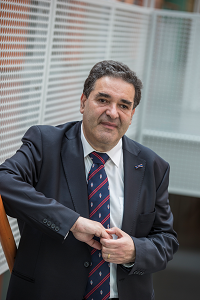- Speaker
- Prof. Mikhail I. Katsnelson
- Radboud University, Nijmegen, Netherlands
- Abstract
Magnetic ordering and related phenomena are of essentially quantum and essentially many-body origin and require strong enough electron-electron interactions. Also, they are very sensitive to the details of electronic structure of specific materials. This makes a truly microscopic description of exchange interactions a challenging task. Long ago we suggested a general scheme of calculations of exchange interactions responsible for magnetism based on the magnetic force theorem. It was formulated originally as a method to map the spin-density functional to effective classical Heisenberg model, the exchange parameters turned out to be, in general, essentially dependent on initial magnetic configuration and not universal. However, they are directly related to the spin-wave spectrum and, thus, can be verified experimentally. This approach also lies in the base of "ab initio spin dynamics"within the density functional approach. It is well known now that this scheme is, in general, insufficient for strongly correlated systems and should be combined with the mapping to the multiband Hubbard model and use of, say, dynamical mean-field theory (DMFT) to treat the latter. Our original approach can be reformulated within the DMFT. The method can be also modified to calculate Dzialoshinskii-Moriya interactions which play a crucial role in the phenomenon of weak ferromagnetism, in physics of magnetic skyrmions, and in magnonics/spintronics in general. I will discuss both general methods and their applications to electronic structure and magnetism of various groups of magnetic materials including elemental transition and rare-earth metals, half-metallic ferromagnets, transition metal oxides, molecular magnets, and sp electron magnets based on adatoms on Si surface.
- About the Speaker
Professor Katsnelson obtained his bachelor and PhD from Ural State University in 1977 and 1980; From 1977 to 2001 he was working in the Institute of Metal Physics in Ekaterinburg in Russia, and hold a position as the head of the group of Quantum Theory of Metals. He became the youngest physicist - Doctor of Sciences in the Soviet Union (1985) and received Lenin Komsomol Prize, the State Prize for young researchers (1988). After working for several years as a visiting professor in Uppsala University (Sweden), in 2004, he became professor of theoretical physics and head of the group of Theory of Condensed Matter in Radboud University Nijmegen, the Netherlands. Prof. Katsnelson works in many fields of physics, from foundations of quantum mechanics to applications of statistical physics in biology. His best-known achievements are in the theory of graphene, magnetism and strongly correlated systems. He is awarded by Spinoza Prize (the top scientific award in Netherlands), Hamburg Prize in Theoretical Physics and by Royal decoration as a Knight of the Order of the Netherlands Lion. Prof. Katsnelson is elected member of Royal Netherlands Academy of Arts and Sciences, Academia Europaea and Royal Society of Sciencesat Uppsala and honorary doctor of Uppsala University.
- Date&Time
- 2019-03-26 10:00 AM
- Location
- Room: A303 Meeting Room




